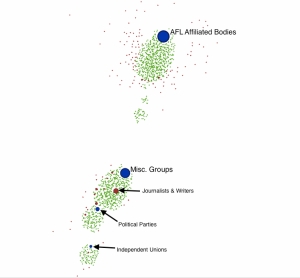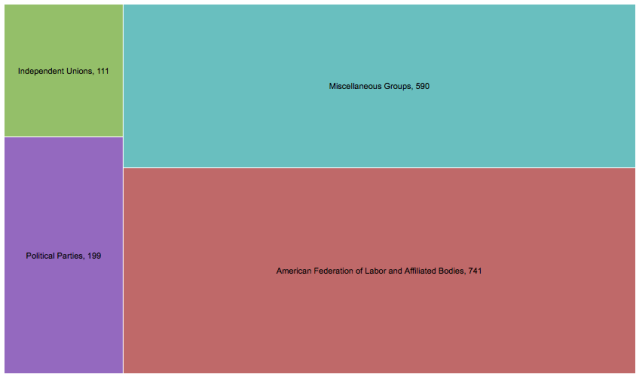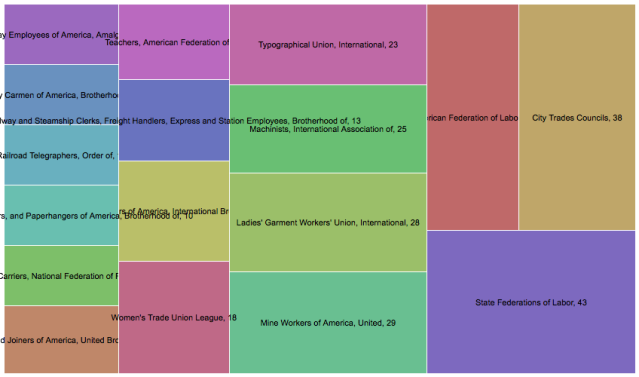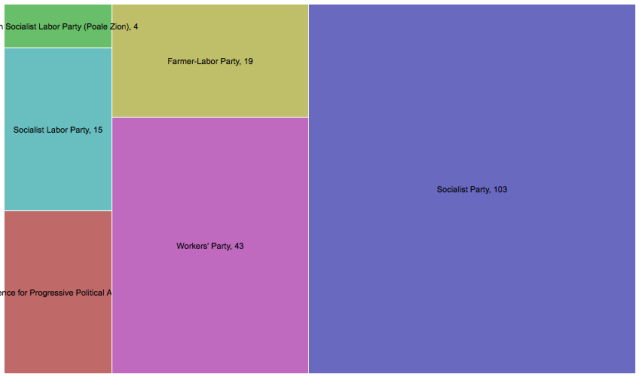This is the second in a series of posts I expect to write to help me think through the use of network analysis and visualization. Read the first post, and a backgrounder.

As one of my correspondents said of my last post: interesting picture, but it’s meaningless without the background data. Well, maybe not meaningless, but abstracted in the extreme. So I’m going to back up a bit, partly for my own sake, to scope out the major categories, subcategories and organizations in the dataset (i.e., the blue and red dots in the chart to the right).
To review, this data is drawn from the index of the digitized version of the American Labor Who’s Who (1925), so it represents what the compilers thought were the relevant organizational contexts for the people listed in the directory at the time it was printed. The actual entries in the Who’s Who often include min-career histories, which makes them potentially more interesting, but also more complicated to work with as data.
Rather than run tables, I’ve made these “tree map” images with Raw, which is a great tool, but has limited ability to adjust labels, so some of these are a little messy. The major categories are AFL-affiliated Bodies, Independent Unions, Political Parties and Miscellaneous Groups (numbers represent individuals in the category, some people are in more than one category):
 The AFL, Political Parties, and Independent Unions encompass organizations. “Miscellaneous Groups” includes specific organizations and functional subcategories (e.g., Journalists and Writers, Impartial Arbitrators, as well as League for Industrial Democracy.). The AFL-affiliated group is large and full of little organizations with one or two people listed. Here’s a chart of the AFL-affiliated organizations with 10 or more members in the Who’s Who. It’s interesting that the Women’s Trade Union League makes it into this list because women are otherwise underrepresented.
The AFL, Political Parties, and Independent Unions encompass organizations. “Miscellaneous Groups” includes specific organizations and functional subcategories (e.g., Journalists and Writers, Impartial Arbitrators, as well as League for Industrial Democracy.). The AFL-affiliated group is large and full of little organizations with one or two people listed. Here’s a chart of the AFL-affiliated organizations with 10 or more members in the Who’s Who. It’s interesting that the Women’s Trade Union League makes it into this list because women are otherwise underrepresented.

Below is a breakdown of the “Independent Unions” where I’ve combined all the railway unions for the sake of getting a better chart. There was one representative of African American rail unionism in that group, but Brotherhood of Sleeping Car Porters (founded in 1925) didn’t make it into the Who’s Who. A. Philip Randolph, Chandler Owen and a few others appear under “Negro Progress” groups and in some AFL unions. So the Amalgamated Clothing Workers is really the largest non-AFL union in the Who’s Who. Also worth noting, by 1925 many militants had moved on from the Industrial Workers of the World (IWW). So in the index they have no connection, whereas their entries often list former membership.

The next subcategory is Political Parties. In the actual directory quite a few people are listed as Democrats and Republicans, but not in the index. So this is really “left political parties” or “working-class political parties.”

And finally, that large category “Miscellaneous Groups.” In later posts I’ll zero in on “Journalists and Writers” as well as a key group of individuals that link the AFL unions with the para-union organizations.

The printed Who’s Who also has a geographic index, but I have yet to convert that into a spreadsheet. It would be interesting to see how the categories, subcategories and organizations look spatially. But that will have to wait for another day.
Next up, I return to Gephi and the network charts, add the links between groups and explore some individuals who seem to occupy key positions between the two poles of the 1920s labor movement.